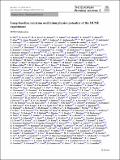Long-baseline neutrino oscillation physics potential of the DUNE experiment
Author(s)
Abi, B.; Acciarri, R.; Acero, M. A; Adamov, G.; Adams, D.; Adinolfi, M.; Ahmad, Z.; Ahmed, J.; Alion, T.; Monsalve, S. A; Alt, C.; Anderson, J.; Andreopoulos, C.; Andrews, M. P; Andrianala, F.; Andringa, S.; Ankowski, A.; Antonova, M.; Antusch, S.; Aranda-Fernandez, A.; ... Show more Show less
Download10052_2020_Article_8456.pdf (4.977Mb)
Publisher with Creative Commons License
Publisher with Creative Commons License
Creative Commons Attribution
Terms of use
Metadata
Show full item recordAbstract
Abstract
The sensitivity of the Deep Underground Neutrino Experiment (DUNE) to neutrino oscillation is determined, based on a full simulation, reconstruction, and event selection of the far detector and a full simulation and parameterized analysis of the near detector. Detailed uncertainties due to the flux prediction, neutrino interaction model, and detector effects are included. DUNE will resolve the neutrino mass ordering to a precision of 5
$$\sigma $$
σ
, for all
$$\delta _{\mathrm{CP}}$$
δ
CP
values, after 2 years of running with the nominal detector design and beam configuration. It has the potential to observe charge-parity violation in the neutrino sector to a precision of 3
$$\sigma $$
σ
(5
$$\sigma $$
σ
) after an exposure of 5 (10) years, for 50% of all
$$\delta _{\mathrm{CP}}$$
δ
CP
values. It will also make precise measurements of other parameters governing long-baseline neutrino oscillation, and after an exposure of 15 years will achieve a similar sensitivity to
$$\sin ^{2} 2\theta _{13}$$
sin
2
2
θ
13
to current reactor experiments.
Date issued
2020-10-22Department
Massachusetts Institute of Technology. Department of PhysicsPublisher
Springer Berlin Heidelberg
Citation
The European Physical Journal C. 2020 Oct 22;80(10):978
Version: Final published version